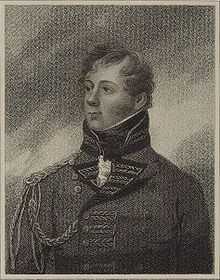Rollo Gillespie
| Rollo Gillespie | |
|---|---|
 Major-General Sir Robert Rollo Gillespie | |
| Born |
1766 Comber, County Down |
| Died |
1814 Kalunga, Dehradun, India, The then Nepal |
| Allegiance |
|
| Years of service | 1783 - 1814 |
| Rank | Major-General |
| Battles/wars |
French Revolutionary Wars Gurkha War |
Major-General Sir Robert Rollo Gillespie (21 January 1766 – 31 October 1814[1]) was an officer in the British army.
Early life
Robert Rollo Gillespie was born and grew up in Comber, County Down, in what is now Northern Ireland.[2] He was educated at Kensington and near Newmarket[1] After turning down the opportunity of going to Cambridge university he joined the 3rd Irish Horse during 1783[1] as a Cornet.
In 1786 he was involved in a duel in which he killed the opposing duellist . Fleeing to Scotland, he stayed briefly and then returned voluntarily to stand trial in 1788. The verdict was 'justifiable homicide' and Gillespie was acquitted.[1]
Active service
In 1792 he transferred to the Light Dragoons with the rank of lieutenant and soon embarked with his new regiment for Jamaica. However, his ship was shipwrecked at the Portuguese islands of Madeira forcing Gillespie to come ashore by a small boat and he then contracted yellow fever[1] in his first night on the island. After recovery, he rejoined his regiment and fought against the forces of the French republic in the Caribbean at Tiburon Peninsula, Port-au-Prince, Fort Bizotten and Fort de l'Hôpital.
Being made Adjutant-General of St. Domingo, he was at home alone when eight men broke into his house to burgle it. Armed only with his sword, he killed six of them while the other two fled.
India, Java, Sumatra, Nepal
In 1804 he was honourably acquitted[1] by a court martial of suspected involvement in a fraud scandal after which he transferred to India, travelling overland through Hamburg, Greece and Baghdad to take command of the 19th Light Dragoons. During the Vellore Mutiny of 1806 Gillespie set out with a relief force from the 19th within a quarter of an hour of the alarm being raised. Dashing ahead with twenty men, he saw the surviving British troops, about sixty men of the 69th commanded by NCOs and two assistant surgeons, holding the ramparts but out of ammunition. As he was unable to gain entry through the defended gate (which was controlled by the mutineers), Gillespie climbed the wall onto the battlements to take command with the aid of a rope and a sergeant's sash which was lowered to him. To gain time for the rest of the 19th to arrive he led the 69th in a bayonet-charge along the ramparts, engaging in close combat with the enemy. With the rest of the 19th now arrived Gillespie ordered them to blow in the gates with their galloper guns and then made a second charge with the 69th clearing the space just inside the gate to permit the cavalry to deploy. The 19th and Madras Cavalry then charged and slaughtered any enemy who stood in their way.
In 1811 he commanded forces in the Invasion of Java[1] and took the city of Batavia. He was subsequently appointed Commander of the Forces in British-occupied Java and in 1812 he deposed the Sultan of Palembang in Sumatra, and took the royal Javanese city of Yogyakarta. On his return to India he speared a tiger that escaped from a cage and prowled on Bangalore racecourse.[3]
Two years later, at the beginning of the Anglo-Nepalese War, he led a column to attack a Nepalese hill fort at Kalunga, in the Battle of Nalapani, repulsing a Gurkha counter-attack. Gillespie then tried to follow them back into the fort with a dismounted party of the 8th Dragoons. Although this failed, Gillespie renewed the attack with companies of the 53rd Foot. Thirty yards from the fort he shouted the words, "One shot more for the honour of Down" and charged with the men when a Nepalese sharpshooter shot him through the heart and he died within seconds of falling. With his death the attack faltered causing the next senior officer to call a retreat.[1]
He was posthumously knighted with a K.C.B. on 1 January 1815.[1]
Memorial
A large statue of Major General Sir Rollo Gillespie was constructed under the oversight of John Fraser, the first County Surveyor of Down, and was unveiled on 24 June 1845 (St. John's Day) in the Town Square of Comber. Fifty lodges of the Masonic Order were present, in what is believed to be the biggest Masonic gathering in Irish history. It was calculated that 25,000 to 30,000 people crowded into the town to witness the ceremony. The column is 55 feet high. At the foot of the column are many Masonic symbols and his famous last words "One shot more for the honour of Down".
References
- ↑ 1.0 1.1 1.2 1.3 1.4 1.5 1.6 1.7 1.8 Dictionary of Indian Biography; Charles E Buckland p166 (1906)
- ↑ Sandford, Ernest (1976). Discover Northern Ireland. NI Tourist Board. p. 197. ISBN 0 9500222 7 6.
- ↑ Thornton, Leslie Heber (1925). Campaigners Grave & Gay: Studies of Four Soldiers of the Eighteenth and Nineteenth Centuries. The University Press. p. 105.
Further reading
- A Memoir of Major-General Sir R. R. Gillespie
- Hernon, Ian. (2001) Blood in the Sand: More Forgotten Wars of the 19th Century, The History Press.